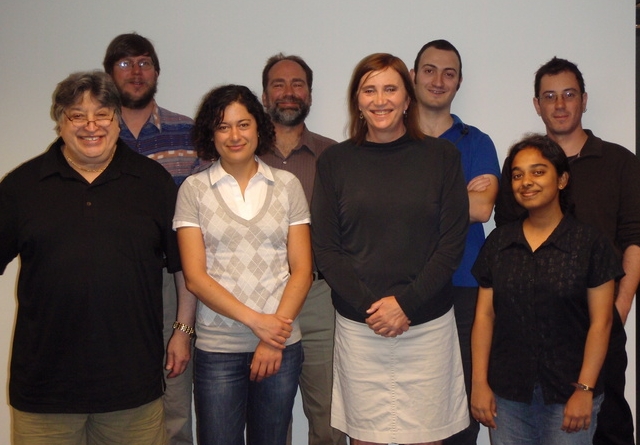| Description | Participants | Summaries | Products | Feature |
|---|

Archived NIMBioS Working Group
Function and Evolution
Topic: Integrating Functional and Evolutionary Dynamics at Multiple Scales
Meeting dates: June 10-12, 2009; March 1-3, 2010; September 13-17, 2010
Organizers:
Erol Akçay (Univ. of Tennessee, Knoxville)
Joan Roughgarden (Dept. of Biology, Stanford Univ.)
Objectives: The working group will model the dynamics of biological systems at the functional and evolutionary levels, and integrate these two in a unified framework. From cells to human societies, biological organization emerges from the interaction of individual parts. The dynamics of these interactions are governed by the interaction mechanisms. Even though these mechanisms themselves are ultimately products of evolution, the functional dynamics they produce are not identical to the evolutionary dynamics and operate at different scales. In order to explain the emergence of biological organization, we need to integrate both functional and evolutionary dynamics.
The working group will develop the theoretical framework for this task. Particular focal topics that will be addressed are: the evolution of pay-offs and trade-offs in biological interactions, the evolution of interaction mechanisms, and the modeling of the interplay between different types of functional dynamics. The working group will integrate the results from these focal investigations in a multi-scale theoretical framework and identify new avenues for theoretical and empirical research opened by this synthesis.

Meeting Summaries
| Mtg # | Dates | Agenda | Summary | Photo | Evaluation |
|---|---|---|---|---|---|
| 1 | Jun 10-12, 2009 | Link | Link | Report | |
| 2 | Mar 1-3, 2010 | Link | Report | ||
| 3 | Sep 13-17, 2010 | Link | Report |
Meeting 1 Summary. During the first meeting, the working group determined the conceptual issues and problems underscoring the group’s research interests and approaches. One broad conceptual issue focuses on the constraints that occur with different functional dynamic and how these functional dynamics interact with evolutionary dynamics. The group identified several research questions that would benefit from an approach that integrates functional and evolutionary dynamics, such as the evolution of emotions and a dynamical and biological classification of different solution concepts for evolutionary game theory. The group developed an outline of a review paper that will survey the uses of evolutionary game theory and multi-tier approaches across broad scales of biological organization, from individual behavior to macroecology. In addition, several collaborative projects were initiated with the goal of having at least preliminary results by the next meeting, scheduled for March 1-3, 2010.
Meeting 2 Summary. The second meeting began with presentations by group members of work initiated in the past meeting, discussing the progress and future plans for the work. Also discussed were a series of recent papers by members of the group on reproductive social behavior and sexual selection, focusing on what type of models would be needed to differentiate between different theories of reproductive behavior. During the second and third days, break-out groups continued the ongoing projects and started a few new ones, including one on contrasting models of evolution of sex-specific ornaments and a paper on the use of evolutionary game theory in quantitative biology education. Our next meeting will be in September 2010, when we will be joined by two new members of the group who bring in expertise in game theoretic approaches in political science.
Meeting 3 Summary. The third meeting, which included several new members with game theoretic expertise from political science, began with discussions of recent papers, including one exploring the connections between political science theory and biology. Progress reports about the group's ongoing projects, which focus on the idea of levels and hierarchies in ecological and biological theory, were also given. Several research projects and the sub-groups to carry them out were identified, including models of parent-offspring communication in the behavioral time-scale and models of sexually dimorphic ornaments. Break-out groups worked on relevant models. A special focus was on how the theory of mechanism design from economics can be applied and adapted to models of communication, especially between parents and offspring. Because this was our last meeting, we also made detailed plans about how to finish and write up the work we have done. The group estimates a total of 10 manuscripts that span topics ranging from the idea of levels in biology to models of prey-predators and parent-offspring interactions. The target time frame for most of the papers to be ready for submission is by early 2011.
 |
| Meeting 1 participants (Back row, L to R): Brian McGill, Joel Brown, Erol Akçay, Lee Worden; (Front row, L to R): Herbert Gintis, Angela Potochnik, Joan Roughgarden, Priya Iyer; (Not Pictured): Louis Gross, Eric Vanden-Eijnden, Tom Vincent. |
NIMBioS Working Groups are chosen to focus on major scientific questions at the interface between biology and mathematics. NIMBioS is particularly interested in questions that integrate diverse fields, require synthesis at multiple scales, and/or make use of or require development of new mathematical/computational approaches. NIMBioS Working Groups are relatively small (up to 10 participants), focus on a well-defined topic, and have well-defined goals and metrics of success. Working Groups will meet up to 3 times over a two-year period, with each meeting lasting up to 2.5 days.
A goal of NIMBioS is to enhance the cadre of researchers capable of interdisciplinary efforts across mathematics and biology. As part of this goal, NIMBioS is committed to promoting diversity in all its activities. Diversity is considered in all its aspects, social and scientific, including gender, ethnicity, scientific field, career stage, geography and type of home institution. Questions regarding diversity issues should be directed to diversity@nimbios.org. You can read more about our Diversity Plan on our NIMBioS Policies web page. The NIMBioS building is fully handicapped accessible.
NIMBioS
1122 Volunteer Blvd., Suite 106
University of Tennessee
Knoxville,
TN 37996-3410
PH: (865) 974-9334
FAX: (865) 974-9461
Contact NIMBioS


